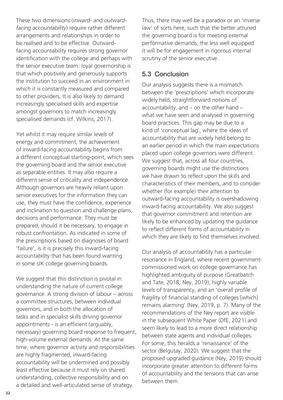
22
These two dimensions (inward- and outwardfacing accountability)
require rather different
arrangements and relationships in order to
be realised and to be effective. Outwardfacing accountability requires strong governor
identification with the college and perhaps with
the senior executive team: loyal governorship is
that which positively and generously supports
the institution to succeed in an environment in
which it is constantly measured and compared
to other providers. It is also likely to demand
increasingly specialised skills and expertise
amongst governors to match increasingly
specialised demands (cf. Wilkins, 2017).
Yet whilst it may require similar levels of
energy and commitment, the achievement
of inward-facing accountability begins from
a different conceptual starting-point, which sees
the governing board and the senior executive
as separable entities. It may also require a
different sense of criticality and independence.
Although governors are heavily reliant upon
senior executives for the information they can
use, they must have the confidence, experience
and inclination to question and challenge plans,
decisions and performance. They must be
prepared, should it be necessary, to engage in
robust confrontation. As indicated in some of
the prescriptions based on diagnoses of board
'failure', is it is precisely this inward-facing
accountability that has been found wanting
in some UK college governing boards.
We suggest that this distinction is pivotal in
understanding the nature of current college
governance. A strong division of labour - across
a committee structures, between individual
governors, and in both the allocation of
tasks and in specialist skills driving governor
appointments - is an efficient (arguably,
necessary) governing board response to frequent,
high-volume external demands. At the same
time, where governor activity and responsibilities
are highly fragmented, inward-facing
accountability will be undermined and possibly
least effective because it must rely on shared
understanding, collective responsibility and on
a detailed and well-articulated sense of strategy.
Thus, there may well be a paradox or an 'inverse
law' of sorts here, such that the better attuned
the governing board is for meeting external
performative demands, the less well equipped
it will be for engagement in rigorous internal
scrutiny of the senior executive.
5.3 Conclusion
Our analysis suggests there is a mismatch
between the 'prescriptions' which incorporate
widely held, straightforward notions of
accountability, and - on the other hand -
what we have seen and analysed in governing
board practices. This gap may be due to a
kind of 'conceptual lag', where the ideas of
accountability that are widely held belong to
an earlier period in which the main expectations
placed upon college governors were different.
We suggest that, across all four countries,
governing boards might use the distinctions
we have drawn to reflect upon the skills and
characteristics of their members, and to consider
whether (for example) their attention to
outward-facing accountability is overshadowing
inward-facing accountability. We also suggest
that governor commitment and retention are
likely to be enhanced by updating the guidance
to reflect different forms of accountability in
which they are likely to find themselves involved.
Our analysis of accountability has a particular
resonance in England, where recent governmentcommissioned work on college governance has
highlighted ambiguity of purpose (Greatbatch
and Tate, 2018; Ney, 2019), highly variable
levels of transparency, and an 'overall profile of
fragility of financial standing of colleges [which]
remains alarming' (Ney, 2019, p. 7). Many of the
recommendations of the Ney report are visible
in the subsequent White Paper (DfE, 2021) and
seem likely to lead to a more direct relationship
between state agents and individual colleges.
For some, this heralds a 'renaissance' of the
sector (Belgutay, 2020). We suggest that the
proposed upgraded guidance (Ney, 2019) should
incorporate greater attention to different forms
of accountability and the tensions that can arise
between them.